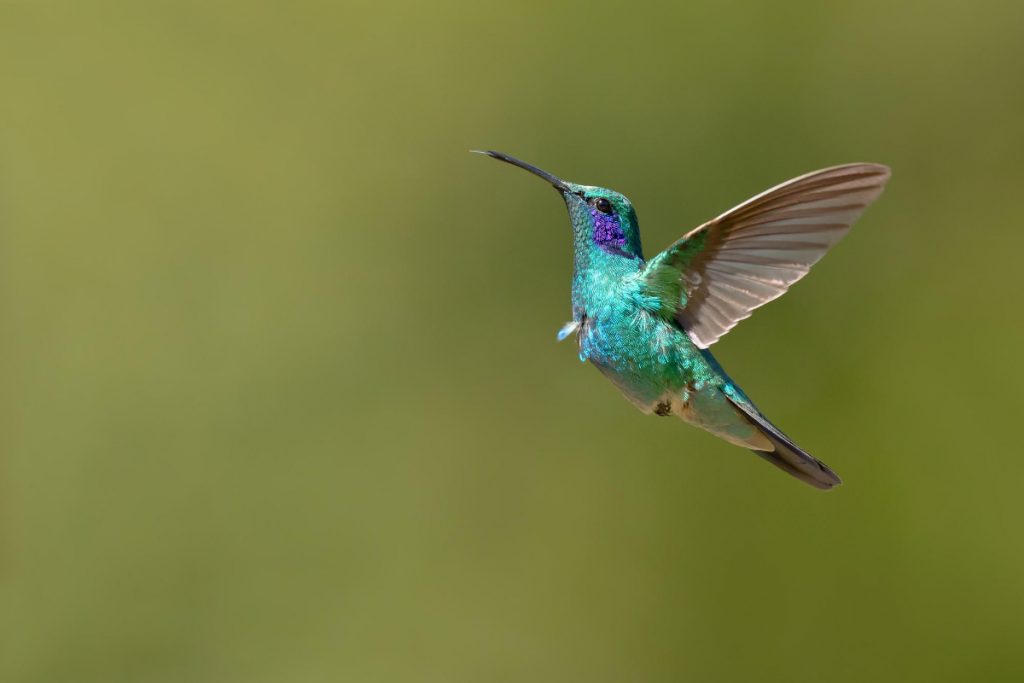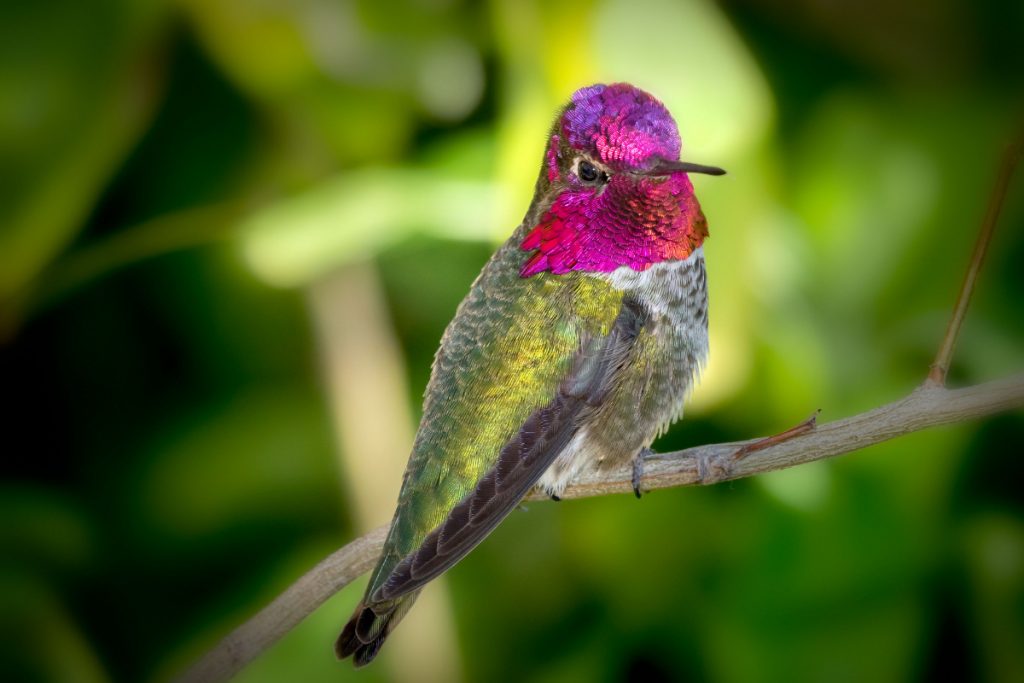When most people think of hummingbirds, the ruby-throated hummingbird likely comes to mind first. With its bright red throat and rapid wing beats, this species is the most widespread and commonly seen hummingbird across much of eastern North America. But did you know that Ohio has been host to a total of seven different hummingbird species over the years?
In this blog post, we’ll take a closer look at each type of hummingbird that has been documented in the state of Ohio. Some are common visitors, while others are rare vagrants that show up only occasionally. We’ll go over-identification tips, migration patterns, feeding behaviors, and the best ways to attract them to your own backyard.
So, let’s explore the diversity of hummingbirds that call Ohio home!
7 Different Types Of Hummingbirds Found In Ohio:
| Hummingbird Species | Abundance | Physical Description |
| Ruby-throated Hummingbird | Common | Green back, white belly, red throat on males |
| Rufous Hummingbird | Uncommon | Orange back and belly, red throat on males |
| Black-chinned Hummingbird | Rare | Green back, white belly with purple throat patch on males |
| Mexican Violetear | Very Rare | Violet ear patches on males |
| Calliope Hummingbird | Rare | Small, streaked throats on males |
| Allen’s Hummingbird | Very Rare | Green back, rusty sides, orange throat on males |
| Anna’s Hummingbird | Very Rare | Green back, grey belly, magenta throat on males |
Related post to read: The Secret Lives of Hummingbirds
Common Hummingbird In Ohio

1. Ruby-throated hummingbird
The ruby-throated hummingbird (Archilochus colubris) is by far the most widespread and commonly found hummingbird in Ohio. It can be found statewide in spring and summer as it breeds and nests across the region.
Males are unmistakable with their bright metallic green backs and heads, white undersides, and, of course, their namesake brilliant red throats. Females lack the red throat and are more white underneath rather than green above. Both have long, thin bills adapted for drinking nectar from flowers.
These tiny birds arrive in Ohio each spring, usually in late April or early May. They’ve just completed a 500-mile non-stop migration across the Gulf of Mexico from their wintering grounds in Central America!
Throughout the summer breeding season, Ruby-throats aggressively defend feeding territories around nectar-rich flowers and feeders. Males perform elaborate aerial displays, flying in loops and dive bombs to impress females and ward off intruders.
By late September, Ruby-throats begin migrating back south to Central America. They fly non-stop over the Gulf once more, an incredible feat for a bird that weighs less than a penny!
Related post to read about Best Hummingbird Feeders.

Uncommon Types Of Hummingbirds in Ohio
Beyond the ruby-throat, several other species of hummingbirds have shown up in Ohio as rare migrants. Birdwatchers should watch for these unexpected visitors, especially during spring and fall migration:
2. Rufous Hummingbird
The rufous hummingbird (Selasphorus rufus) is a feisty western species that occasionally wanders east during migration. They have bright orange backs and bellies on the males and greenish backs with rusty flanks on the females.
While very rare, a few rufous hummingbirds pass through Ohio each fall. They are attracted to feeders and will aggressively defend them, chasing off even larger birds!

3. Black-chinned Hummingbird
The black-chinned hummingbird (Archilochus alexandri) is a western cousin of the Ruby-throat. Males have a dark purple throat patch and a white collar, while females are pale below with green backs.
Only one black-chinned hummingbird sighting has been confirmed in Ohio when a female was spotted in 2020. But others likely have gone undetected over the years.
Rare Vagrant Hummingbird Species in Ohio
In addition to migrant hummingbirds, a few vagrant species of hummingbirds have turned up in Ohio as very rare visitors. Birdwatchers should be vigilant for these unexpected hummingbirds:

4. Mexican Violetear Hummingbird
This large hummingbird lives year-round in Central America and southern Mexico. It is an exceptionally rare hummingbird in Ohio, with only a couple of records. Males have violet ear patches (thus the name), and females have white markings on the face.
Interestingly, the Mexican Violetear is somewhat nomadic, and its migration patterns are not well-studied. It prefers forest clearings and edges in its native range but may also visit backyards in Ohio during spring and summer.
Unlike many hummingbird species that feed in groups, the Mexican Violetear forages for nectar and insects alone, making it a solitary feeder. Despite its rarity, the sight of a Mexican Violetear in Ohio is a memorable experience for birdwatchers, adding an exotic touch to the local bird-watching scene.

5. Calliope Hummingbird
The Calliope is the smallest breeding hummingbird in the United States. Males have colorful streaking on their throats. They breed in the western states but occasionally wander east as far as Ohio in fall and winter.

6. Allen’s Hummingbird
This small green and orange hummingbird is a rare winter visitor along the Ohio Lake Erie shoreline. Males have bright reddish-orange throats, and females have grey underparts. It breeds along the Pacific Coast.

7. Anna’s Hummingbird
Another western species, Anna’s hummingbirds, are green with grey undersides. Males have a distinctive magenta head and throat. This species is a very rare winter visitor in Ohio, but sightings have happened near Lake Erie.
Attracting Hummingbirds to Your Backyard
Even though Ruby-throats are the only common species, Ohio birders have a chance to spot some of the rarer hummingbirds, too. Here are some tips to bring hummingbirds to your own backyard:
- Put up nectar feeders with a simple 1:4 ratio of sugar to water. Don’t add red dye; just use plain white sugar. Be sure to change the nectar every few days to prevent spoilage.
- Plant native flowers and shrubs that appeal to hummingbirds, such as bee balms, cardinal flowers, and trumpet vines. They will attract insects, too, which the birds eat.
- Use a hummingbird bath or drippers to provide a freshwater source.
- Avoid using pesticides which can poison the birds or kill off their insect prey.
- Consider special feeders that accommodate rare migrants. Some have perches or feeding ports on the sides used by species other than Ruby-throats.
With the right habitat, you may get lucky and have one of Ohio’s rare hummingbirds decide to visit your yard! It takes some patience and dedication, but it will be hugely rewarding.
Final Thoughts
While the Ruby-throated hummingbird can be found across Ohio in summer, keep an eye out for the possibility of a rarer species dropping by, especially during migration periods. Vagrant hummingbirds often go undetected, so spread the word when one turns up in your area. Share your sightings and photos on community birding websites like the Journey North website.
Learning how to identify the array of hummingbird species makes birdwatching even more interesting. New arrivals could show up at any time in the Buckeye State. So equip your backyard with a diversity of flowers, provide fresh nectar and water, and be ready if a rare hummingbird comes buzzing into your neighborhood!
Now, Over To You!
Please feel free to leave a comment in the comment section below. I’d love to hear your opinion on this. And until next time, thanks for stopping by, and happy bird watching.
Frequently Asked Questions (FAQs)
Q: What are the 7 types of hummingbirds found in Ohio?
A: The 7 types of hummingbirds found in Ohio are the Ruby-throated Hummingbird, Rufous Hummingbird, Black-chinned Hummingbird, Mexican Violetear, Calliope Hummingbird, Allen’s Hummingbird, and Anna’s Hummingbird.
Q: Is the Ruby-throated Hummingbird common in Ohio?
A: Yes, the Ruby-throated Hummingbird is the most common and widespread hummingbird that visits Ohio.
Q: What distinguishes male Rufous Hummingbirds from other species?
A: Male Rufous Hummingbirds have bright orange backs and bellies, making them stand out from other species.
Q: Where do Calliope Hummingbirds usually live?
A: Calliope Hummingbirds typically live in the western United States but are occasional accidental visitors to Ohio.
Q: Are Black-chinned Hummingbirds frequently spotted in Ohio?
A: No, Black-chinned Hummingbirds are rare in Ohio, with only a few confirmed sightings.
Q: How can I attract hummingbirds to my yard in Ohio?
A: To attract hummingbirds in Ohio, set up nectar feeders, plant native tubular flowers, provide fresh water, and avoid using pesticides.
Q: What is unique about the female Ruby-throated Hummingbird’s appearance?
A: Female Ruby-throated Hummingbirds lack the iridescent red throat of males and have a more white underside.
Q: What migration route do Ruby-throated Hummingbirds take?
A: Ruby-throated Hummingbirds migrate between Ohio and Central America, crossing the Gulf of Mexico non-stop.
Q: What type of food do Ohio hummingbirds prefer?
A: Hummingbirds in Ohio feed on nectar from flowers and feeders, as well as small insects and spiders.
Q: How rare are Mexican Violetear Hummingbirds in Ohio?
A: Mexican Violetear Hummingbirds are very rare in Ohio, with only a couple of records.
Q: Do hummingbirds eat during the breeding season?
A: Yes, during the breeding season, hummingbirds actively feed on nectar and insects for energy.
Q: What physical feature is prominent in male Allen’s Hummingbirds?
A: Male Allen’s Hummingbirds are noted for their bright reddish-orange throats and green backs.
Q: Are Calliope Hummingbirds the smallest bird species in the United States?
A: Yes, the Calliope Hummingbird is the smallest bird species in the United States.
Q: How can I distinguish female hummingbirds from male hummingbirds?
A: Female hummingbirds typically lack the bright throat colors seen in males and often have duller feather coloring.
Q: What time of year do hummingbirds usually arrive in Ohio?
A: Hummingbirds usually arrive in Ohio in late April or early May.
Q: Are Rufous Hummingbirds considered common in Ohio?
A: No, Rufous Hummingbirds are uncommon in Ohio, often seen as accidental visitors.
Q: What are the feeding habits of Ohio hummingbirds?
A: Hummingbirds in Ohio feed on nectar from flowers and feeders, as well as small insects, for protein.
Q: Can Black-chinned Hummingbirds be found throughout Ohio?
A: No, Black-chinned Hummingbirds are rare in Ohio and not found throughout the state.
Q: Are hummingbirds known for being vocal in the United States?
A: Yes, hummingbirds, including those in Ohio, are known to be vocal, especially during mating displays.
Q: What is the breeding season for Ruby-throated Hummingbirds in Ohio?
A: The breeding season for Ruby-throated Hummingbirds in Ohio typically spans the summer months.
Useful Links:
Related Posts to Read:
- Do Hummingbirds Beaks Open When Feeding?
- The Mysteries of Hummingbird Flight.
- 6 Fascinating Facts About Hummingbird Sizes.
- Ruby-Throated Hummingbird Migration Map.
- Where Do Hummingbirds Go When It Rains?
- How Much Does A Hummingbird Eat Per Day?
- Hummingbird Diet and Nutrition
- Unveiling 25 Hummingbird Behaviors
- Are Hummingbirds Territorial?
References:
- About Hummingbird (Link).
- Greenewalt, C. H. (1960). Hummingbirds. New York: Doubleday. Google Scholar.
- Carey C. The impacts of climate change on the annual cycles of birds. Philos Trans R Soc Lond B Biol Sci. 2009 Nov 27; 364(1534):3321-30. doi: 10.1098/rstb.2009.0182. PMID: 19833644; PMCID: PMC2781852.
- Rico-Guevara A, Rubega MA, Hurme KJ, Dudley R. Shifting Paradigms in the Mechanics of Nectar Extraction and Hummingbird Bill Morphology. Integr Org Biol. 2019 Jan 2;1(1):oby006. doi: 10.1093/iob/oby006. PMID: 33791513; PMCID: PMC7671138.
- Tyrrell LP, Goller B, Moore BA, Altshuler DL, Fernández-Juricic E. The Orientation of Visual Space from the Perspective of Hummingbirds. Front Neurosci. 2018 Jan 30;12:16. doi: 10.3389/fnins.2018.00016. PMID: 29440985; PMCID: PMC5797624.
- Hummingbirds Sighting (Journey North Map).
- About Hummingbird’s Characteristics.
